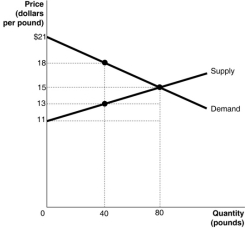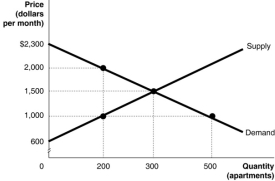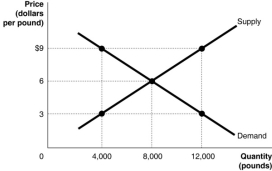B) False
Correct Answer

verified
Correct Answer
verified
Multiple Choice
Figure 5.7  Figure 5.7 shows the market for beer.The government plans to impose a unit tax in this market.
-Refer to Figure 5.7.As a result of the tax, is there a loss in consumer surplus?
Figure 5.7 shows the market for beer.The government plans to impose a unit tax in this market.
-Refer to Figure 5.7.As a result of the tax, is there a loss in consumer surplus?
A) Yes, because consumers are paying a price above the economically efficient price.
B) No, because the producer pays the tax.
C) No, because the market reaches a new equilibrium.
D) No, because consumers are charged a lower price to cover their tax burden.
F) All of the above
Correct Answer

verified
Correct Answer
verified
True/False
Rent control is an example of a price ceiling.
B) False
Correct Answer

verified
Correct Answer
verified
Multiple Choice
Figure 5.1  Figure 5.1 shows Arnold's demand curve for burritos.
-Refer to Figure 5.1.If the market price is $1.50, what is Arnold's consumer surplus?
Figure 5.1 shows Arnold's demand curve for burritos.
-Refer to Figure 5.1.If the market price is $1.50, what is Arnold's consumer surplus?
A) $1.50
B) $2.25
C) $3.00
D) $4.75
F) B) and C)
Correct Answer

verified
Correct Answer
verified
Multiple Choice
Suppose an excise tax of $1 is imposed on every case of beer sold, and sellers are responsible for paying this tax.How would the imposition of the tax be illustrated in a graph?
A) The supply curve for cases of beer would shift to the right by $1.
B) The supply curve for cases of beer would shift to the left by more than $1.
C) The supply curve for cases of beer would shift to the left by less than $1.
D) The supply curve for cases of beer would shift to the left by $1.
F) B) and C)
Correct Answer

verified
Correct Answer
verified
True/False
The excess burden of a tax is also a deadweight loss.
B) False
Correct Answer

verified
Correct Answer
verified
Multiple Choice
Figure 5.3  Figure 5.3 shows the market for tiger shrimp.The market is initially in equilibrium at a price of $15 and a quantity of 80.Now suppose producers decide to cut output to 40 in order to raise the price to $18.
-Refer to Figure 5.3.The value of consumer surplus at a price of $18 is
Figure 5.3 shows the market for tiger shrimp.The market is initially in equilibrium at a price of $15 and a quantity of 80.Now suppose producers decide to cut output to 40 in order to raise the price to $18.
-Refer to Figure 5.3.The value of consumer surplus at a price of $18 is
A) $60
B) $120
C) $180
D) $240
F) All of the above
Correct Answer

verified
Correct Answer
verified
Multiple Choice
In the economic sense, almost everything is scarce.________ of a good or service occurs when the quantity demanded is greater than the quantity supplied at the current market price.
A) Scarcity
B) A shortage
C) A surplus
D) An overstock
F) B) and C)
Correct Answer

verified
Correct Answer
verified
Multiple Choice
The government proposes a tax on imported champagne.Buyers will bear the entire burden of the tax if the
A) supply curve for imported champagne is vertical.
B) demand curve for imported champagne is vertical.
C) demand curve for imported champagne is horizontal.
D) demand curve is downward sloping and the supply curve is upward sloping.
F) B) and C)
Correct Answer

verified
Correct Answer
verified
True/False
The total amount of consumer surplus in a market is equal to the area below the demand curve.
B) False
Correct Answer

verified
Correct Answer
verified
Multiple Choice
Figure 5.1  Figure 5.1 shows Arnold's demand curve for burritos.
-Refer to Figure 5.1.If the market price is $2.00, what is the consumer surplus on the second burrito?
Figure 5.1 shows Arnold's demand curve for burritos.
-Refer to Figure 5.1.If the market price is $2.00, what is the consumer surplus on the second burrito?
A) $0
B) $1.00
C) $2.00
D) $4.50
F) A) and C)
Correct Answer

verified
Correct Answer
verified
Multiple Choice
Figure 5.5  Figure 5.5 shows the market for apartments in Springfield.Recently, the government imposed a rent ceiling of $1000 per month.
-Refer to Figure 5.5.Suppose that instead of a rent ceiling, the government imposed a price floor of $2000 per month for apartments.What is the value of the deadweight loss after the imposition of the price floor?
Figure 5.5 shows the market for apartments in Springfield.Recently, the government imposed a rent ceiling of $1000 per month.
-Refer to Figure 5.5.Suppose that instead of a rent ceiling, the government imposed a price floor of $2000 per month for apartments.What is the value of the deadweight loss after the imposition of the price floor?
A) $50 000
B) $125 000
C) $175 000
D) $260 000
F) C) and D)
Correct Answer

verified
Correct Answer
verified
Multiple Choice
Economic efficiency is defined as a market outcome in which the marginal benefit to consumers of the last unit produced is equal to the marginal cost of production, and in which
A) the sum of consumer surplus and producer surplus is at a maximum.
B) economic surplus is minimised.
C) the sum of the benefits to firms is equal to the sum of the benefits to consumers.
D) the sum of consumer surplus and producer surplus is minimised.
F) A) and B)
Correct Answer

verified
Correct Answer
verified
True/False
Producer surplus is the difference between the lowest price a firm is willing to accept for a product and the price it actually receives for the product.
B) False
Correct Answer

verified
Correct Answer
verified
Multiple Choice
Lucinda buys a new GPS system for $250.She receives consumer surplus of $75 from the purchase.How much does Lucinda value her GPS system?
A) $75
B) $175
C) $250
D) $325
F) All of the above
Correct Answer

verified
Correct Answer
verified
Multiple Choice
Figure 5.3  Figure 5.3 shows the market for tiger shrimp.The market is initially in equilibrium at a price of $15 and a quantity of 80.Now suppose producers decide to cut output to 40 in order to raise the price to $18.
-Refer to Figure 5.3.At a price of $18, consumers are willing to buy 40 metrics of tiger shrimp.Is this an economically efficient quantity?
Figure 5.3 shows the market for tiger shrimp.The market is initially in equilibrium at a price of $15 and a quantity of 80.Now suppose producers decide to cut output to 40 in order to raise the price to $18.
-Refer to Figure 5.3.At a price of $18, consumers are willing to buy 40 metrics of tiger shrimp.Is this an economically efficient quantity?
A) No, the marginal benefit of the 40th unit exceeds the marginal cost of that 80th unit.
B) Yes, otherwise consumers would not buy 40 units.
C) Yes, because $18 shows what consumers are willing to pay for the product.
D) No, the marginal cost of the 40th unit exceeds the marginal benefit of the 40th unit.
F) A) and B)
Correct Answer

verified
Correct Answer
verified
Multiple Choice
The following equations represent the demand and supply for silver pendants. QD = 50 - 2P QS = -10 + 2P What is the equilibrium price (P) and quantity (Q - in thousands) of pendants?
A) P = $15; Q = 20 thousand
B) P = $50; Q = 10 thousand
C) P = $20; Q = 15 thousand
D) P = $10; Q = 30 thousand
F) C) and D)
Correct Answer

verified
Correct Answer
verified
Multiple Choice
Figure 5.4  -Refer to Figure 5.4.The figure above represents the market for pecans.Assume that this is a competitive market.Which of the following is true?
-Refer to Figure 5.4.The figure above represents the market for pecans.Assume that this is a competitive market.Which of the following is true?
A) If the price of pecans is $3, the output will be economically efficient but there will be a deadweight loss.
B) If the price of pecans is $9, consumers will purchase more than the economically efficient output.
C) Both 4000 metrics and 12 000 metrics are economically inefficient rates of output.
D) If the price of pecans is $3, producers will sell 12 000 metrics of pecans, but this output will be economically inefficient.
F) B) and C)
Correct Answer

verified
Correct Answer
verified
Multiple Choice
Figure 5.4  -Refer to Figure 5.4.The figure above represents the market for pecans.Assume that this is a competitive market.If the price of pecans is $9, what changes in the market would result in an economically efficient output?
-Refer to Figure 5.4.The figure above represents the market for pecans.Assume that this is a competitive market.If the price of pecans is $9, what changes in the market would result in an economically efficient output?
A) The price would decrease, the quantity supplied would decrease and the quantity demanded would increase.
B) The quantity supplied would increase, the quantity demanded would decrease and the equilibrium price would decrease.
C) The price would decrease, the demand would increase and the supply would decrease.
D) The price would increase, the quantity demanded would decrease and the quantity supplied would increase.
F) A) and C)
Correct Answer

verified
Correct Answer
verified
Multiple Choice
What is the reduction in economic surplus resulting from not being in competitive equilibrium?
A) Marginal cost
B) Producer atrophy
C) Deadweight loss
D) Economic shortage
F) B) and D)
Correct Answer

verified
Correct Answer
verified
Showing 21 - 40 of 187
Related Exams